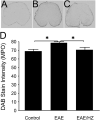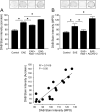Neuroprotection by acrolein sequestration through exogenously applied scavengers and endogenous enzymatic enabling strategies in mouse EAE model
- PMID: 38472318
- PMCID: PMC10933361
- DOI: 10.1038/s41598-024-56035-z
Neuroprotection by acrolein sequestration through exogenously applied scavengers and endogenous enzymatic enabling strategies in mouse EAE model
Abstract
We have previously shown that the pro-oxidative aldehyde acrolein is a critical factor in MS pathology. In this study, we found that the acrolein scavenger hydralazine (HZ), when applied from the day of induction, can suppress acrolein and alleviate motor and sensory deficits in a mouse experimental autoimmune encephalomyelitis (EAE) model. Furthermore, we also demonstrated that HZ can alleviate motor deficits when applied after the emergence of MS symptoms, making potential anti-acrolein treatment a more clinically relevant strategy. In addition, HZ can reduce both acrolein and MPO, suggesting a connection between acrolein and inflammation. We also found that in addition to HZ, phenelzine (PZ), a structurally distinct acrolein scavenger, can mitigate motor deficits in EAE when applied from the day of induction. This suggests that the likely chief factor of neuroprotection offered by these two structurally distinct acrolein scavengers in EAE is their common feature of acrolein neutralization. Finally, up-and-down regulation of the function of aldehyde dehydrogenase 2 (ALDH2) in EAE mice using either a pharmacological or genetic strategy led to correspondent motor and sensory changes. This data indicates a potential key role of ALDH2 in influencing acrolein levels, oxidative stress, inflammation, and behavior in EAE. These findings further consolidate the critical role of aldehydes in the pathology of EAE and its mechanisms of regulation. This is expected to reinforce and expand the possible therapeutic targets of anti-aldehyde treatment to achieve neuroprotection through both endogenous and exogenous manners.
© 2024. The Author(s).
Conflict of interest statement
Riyi Shi is the co-founder of Neuro Vigor, a start-up company with business interests of developing effective therapies for CNS neurodegenerative diseases and trauma. There is not a conflict of interest for Jonathan Tang, Anna Alford, Gary Leung, and Melissa Tully.
Figures







Similar articles
-
Mitigation of sensory and motor deficits by acrolein scavenger phenelzine in a rat model of spinal cord contusive injury.J Neurochem. 2016 Jul;138(2):328-38. doi: 10.1111/jnc.13639. Epub 2016 May 16. J Neurochem. 2016. PMID: 27060873 Free PMC article.
-
Anti-acrolein treatment improves behavioral outcome and alleviates myelin damage in experimental autoimmune encephalomyelitis mouse.Neuroscience. 2011 Jan 26;173:150-5. doi: 10.1016/j.neuroscience.2010.11.018. Epub 2010 Nov 26. Neuroscience. 2011. PMID: 21081153 Free PMC article.
-
Detoxification of Reactive Aldehydes by Alda-1 Treatment Ameliorates Experimental Autoimmune Encephalomyelitis in Mice.Neuroscience. 2021 Mar 15;458:31-42. doi: 10.1016/j.neuroscience.2021.01.021. Epub 2021 Jan 23. Neuroscience. 2021. PMID: 33493617
-
Attenuation of the effects of oxidative stress by the MAO-inhibiting antidepressant and carbonyl scavenger phenelzine.Chem Biol Interact. 2019 May 1;304:139-147. doi: 10.1016/j.cbi.2019.03.003. Epub 2019 Mar 8. Chem Biol Interact. 2019. PMID: 30857888 Review.
-
New insights in the pathogenesis of multiple sclerosis--role of acrolein in neuronal and myelin damage.Int J Mol Sci. 2013 Oct 9;14(10):20037-47. doi: 10.3390/ijms141020037. Int J Mol Sci. 2013. PMID: 24113583 Free PMC article. Review.
Cited by
-
The Pathological Role and Therapeutic potential of ALDH2 in acrolein detoxification Following Spinal Cord Injury in Mice.bioRxiv [Preprint]. 2025 Jun 8:2025.06.08.658505. doi: 10.1101/2025.06.08.658505. bioRxiv. 2025. PMID: 40501858 Free PMC article. Preprint.
-
Temporal differential effects of post-injury alcohol consumption in a mouse model of blast-induced traumatic brain injury.Neuroscience. 2024 Dec 6;562:239-251. doi: 10.1016/j.neuroscience.2024.10.003. Epub 2024 Oct 5. Neuroscience. 2024. PMID: 39369945
References
MeSH terms
Substances
Grants and funding
LinkOut - more resources
Full Text Sources
Research Materials
Miscellaneous

